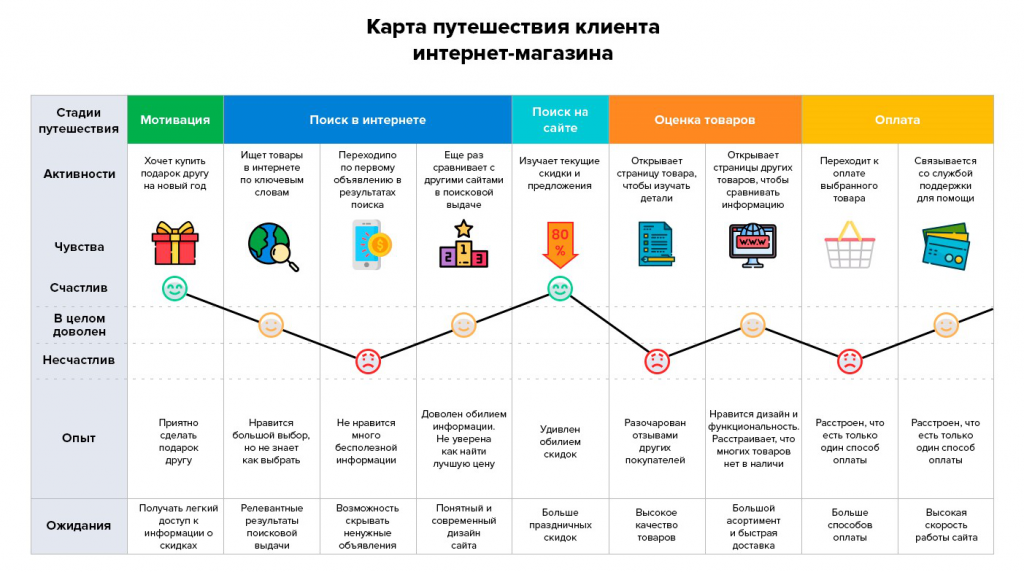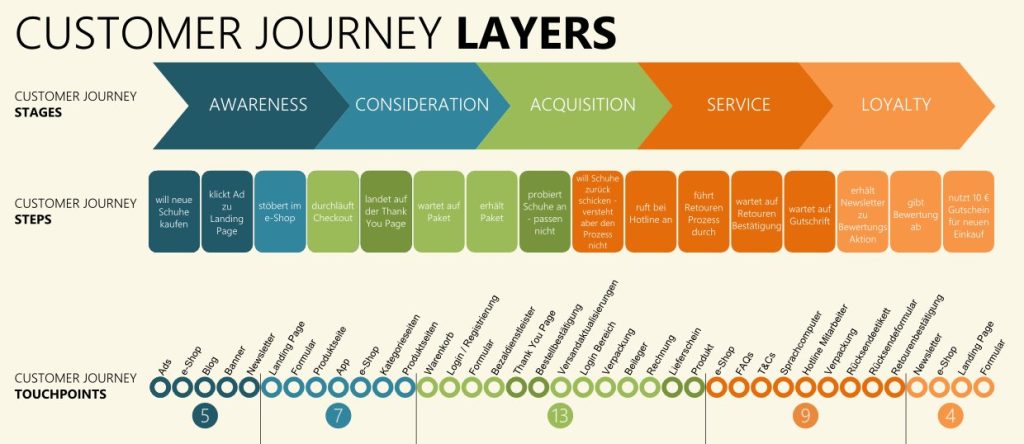A Customer Journey Map (CJM) is a powerful tool for understanding the customer experience and optimizing engagement at every stage of their interaction with your company. Creating a CJM helps identify customer needs and expectations, as well as identify areas where the experience can be improved. In this article, we'll explore how to create an effective Customer Journey Map and provide tips and recommendations for the process.
Define the purpose and scope of CJM
Before you begin creating a Customer Journey Map, you need to define its purpose. What do you hope to achieve by creating a CJM? Perhaps you want to improve conversion rates on your website, enhance customer satisfaction, or explore opportunities for new products or services. It's also important to define the CJM's scope—which channels and stages of the customer interaction will you address.
Defining the CJM goal is the starting point for creating a detailed and informative customer journey mapping. The goal can vary depending on the specific needs and goals of the company.
Some common goals include:
- Understanding customer needs and desires: The goal may be to research and identify the key motivations, requirements, and preferences of customers at different stages of their journey. This allows the company to better tailor its products and services to the needs of its target audience.
- Improving the customer experience: The goal may be to identify bottlenecks and problem areas in the customer journey in order to develop strategies and tools to enhance the user experience. This could include simplifying the purchasing process, improving service levels, or developing personalized recommendations.
- Improving customer satisfaction: The goal may be to create deeper and more meaningful interactions with customers at every stage of their journey. This may include providing additional informational resources, educational materials, or opportunities for feedback and brand engagement.
Defining CJM coverage involves identifying all key stages and interactions a customer might have with a brand. It begins with the customer's initial contact with the brand and includes all subsequent stages, such as research, purchase decision, purchase, product or service use, and post-purchase service. It's important to consider all possible communication channels and touchpoints, including the website, social media, email, mobile apps, and physical stores.
When determining the scope of a CJM, it's important to consider various customer segments and personas, as well as their needs and preferences at each stage of the journey. This will help create more accurate and useful customer journey maps, which can be used to develop marketing strategies.

Research your target audience
To create an accurate Customer Journey Model, you need to thoroughly understand your target audience. Research their needs, motivations, challenges, and expectations. Analyze customer data, conduct interviews or surveys, and study reviews and comments to gain a complete picture of the customer experience.
Here are a few steps to help you understand your target audience more fully and accurately.
- Audience segmentation: Divide your audience into segments based on specific criteria, such as geography, age, gender, income, interests, and behavioral characteristics. This will help you better understand different consumer groups and their needs.
- Market Research: Conduct market research to gain insights into your audience, their preferences, behavioral trends, and needs. Use surveys, focus groups, data analysis, and other research methods to gather the most useful information.
- Create buyer personas: Develop buyer personas—representations of typical representatives of your target audience. Include the demographics, goals, needs, challenges, and motivations of each persona. This will help you better understand your customers and tailor your strategy to their needs.
- Interviews and observations: Interview representatives of your target audience and observe their behavior. This will allow you to gain a deeper understanding of their motivations, needs, and challenges, as well as identify potential points of contact with your brand.
- Competitor Analysis: Study your competitors and their target audiences. Analyze how they attract and engage with customers to identify strengths and weaknesses and identify opportunities for various stages of CJM.
- Leverage data analytics: Use analytics data, such as web analytics and social media analytics, to gain insights into your target audience's behavior at different stages of the customer journey. This will help you optimize customer engagement and improve their experience.
Understanding your target audience is an ongoing process, so regularly update your research and analyze data to improve your CJM and better meet your audience's needs and expectations. This will help you create a more precise and effective marketing and promotion strategy that will generate more sales and improve customer engagement.

Identify the stages of the customer journey
The next step is to identify the stages a customer goes through when interacting with your company. Typically, a customer journey model includes stages such as awareness, research, decision, purchase, usage, and retention. However, each company may have its own unique stages, reflecting its business processes.
Let's look at practical examples and approaches that will help you in this process.
Stage of awareness of needs
At this stage, customers recognize they have a specific need they want to satisfy. For example, let's imagine you own an electronics retail store. Your customer, Anna, is interested in buying a new smartphone because her current one is outdated and doesn't meet her needs.
Research and evaluation stage
At this stage, customers research and compare options to make an informed decision. Anna begins her research: she reads reviews, compares the specifications and prices of different smartphone models, and seeks advice from friends and family.
Decision-making stage
The client makes a final purchasing decision based on the information collected. Anna decides to purchase a specific smartphone model and is ready to move on to the next step.
Purchase stage
The customer makes the purchase. Anna goes to your store, selects, and pays for the smartphone she chooses.
Usage stage
After the purchase, the customer begins using the product or service. Anna activates her new smartphone, configures it to suit her needs, and begins using it in her daily life.
The stage of satisfaction or disappointment
At this stage, the customer evaluates their experience with the product or service and forms an opinion about the company. If Anna is completely satisfied with her new smartphone and received excellent service at your store, she may become a loyal customer and recommend your brand to her friends. However, if she experiences problems with the device or receives poor service, she may be disappointed and pass on a negative opinion of your company.
Repeat purchase and loyalty stage
At this stage, the customer may decide to make a repeat purchase and become a loyal customer if their expectations were met. If Anna receives quality post-purchase support and is satisfied with her new smartphone, she may consider purchasing other products from your company or recommend you to her friends.
Every business has its own unique stages of the customer journey, and it is important to identify them in order to create an accurate CJM.

Create customer personas
To make your CJM more concrete and understandable, create customer personas—archetypes representing different segments of your audience. Give each persona a name, age, profession, goals, interests, and characteristics. This will help you better understand the needs and motivations of each customer segment.
Create detailed profiles: For each customer persona, create a detailed profile that includes information about them, their needs, goals, motivations, challenges, and preferences. Also consider their behavior at different stages of the buying cycle.
Build empathy: To create accurate customer personas, you need to build empathy with your audience. Put yourself in your customer's shoes and try to understand what thoughts, emotions, and motivations they might experience at each stage of the buying journey. This will help you create more realistic and accurate personas.
Test and Refine: Once you've created your customer personas, test them against real data and feedback from your customers. Adjust and refine your personas based on the information you gather.
Identify touchpoints and channels
Now move on to identifying touchpoints—the places where customers interact with your company at each stage of their journey. Identify the channels they use, such as your website, social media, email, mobile apps, etc. Keep in mind that each channel may have its own characteristics and impact the customer experience.
Complete each stage of the CJM
Now begin filling out each stage of the CJM. Describe what happens at each stage, what actions the customer takes, what emotions they experience, and what interactions occur between the customer and your company. Use data and research to make this information as accurate and relevant as possible.
Identify problem areas and opportunities
As you analyze each stage of the CJM, pay attention to the pain points the customer faces and opportunities for improving the experience. Notice turning points, moments when the customer might be disappointed or pleasantly surprised. Consider how you can optimize the interaction process and make it more effective and satisfying.
Develop improvement strategies
Based on the identified pain points and opportunities, develop specific strategies to improve each stage of the CJM. For example, you could improve the information on your website, reduce support wait times, or offer personalized content. Ensure your strategies align with customer needs and expectations.

Constantly monitor and update CJM
A Customer Journey Map isn't a static document. It should be continually updated and adapted to changing customer needs and preferences. Regularly monitor customer experience, analyze customer data, and make necessary adjustments to your CJM to ensure it remains relevant and effective.
Here are some reasons why updating CJM is an important task for every company.
- Changing customer behavior: Times are changing, and so are customers. Their needs, preferences, and ways of interacting with a brand may evolve over time. Updating your CJM allows you to recognize these changes and adapt to new customer demands. For example, while most customers previously preferred email for feedback, they may now prefer social media or messaging apps. Updating your CJM allows you to identify new touchpoints and improve communication channels.
- Tracking Changes in Business Processes: Internal business processes can be modified or improved over time. Updating the CJM helps track these changes and identify opportunities for optimization. For example, if a company makes changes to its delivery process, this could impact the customer experience. Updating the CJM allows you to take these changes into account and make appropriate adjustments.
- Fixing Problems and Finding New Opportunities: Updating the CJM helps identify problem areas and improve the customer experience. CJM analysis can reveal bottlenecks where customers are experiencing difficulties or dissatisfaction. Updating the CJM allows you to focus on these issues and find solutions to address them. Furthermore, the CJM can also uncover new opportunities to improve the customer experience that were previously unnoticed.
- Interdepartmental synchronization: CJM is a powerful tool for synchronizing the work of various departments within a company. Updating CJM allows all employees to be updated on the latest changes and customer requirements. This helps create a unified vision of the customer experience and ensure consistency across all stages of customer interaction.
- Monitoring the Competitive Landscape: The competitive landscape is also constantly changing. Updating the CJM allows you to track changes in customer behavior caused by competitors' actions. This helps the company adapt to new challenges and maintain a competitive advantage.
Conclusion: Updating the CJM is an ongoing process that helps companies stay abreast of changes in customer behavior, business processes, and the competitive landscape. This is essential for ensuring a high-quality customer experience, improving brand loyalty, and achieving business goals. Companies that regularly update their CJM and adapt to changes gain a competitive advantage and build long-term customer relationships.
Conclusion
Creating a customer journey map is a process that requires careful analysis and research. However, it allows you to better understand your customers, identify pain points, and optimize their experience. By following the tips and recommendations above, you can create an effective CJM that will help you improve customer engagement and achieve your business goals.







